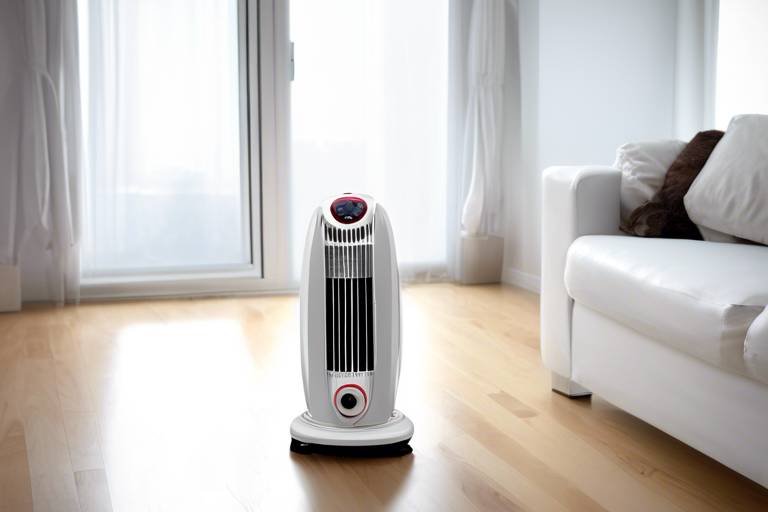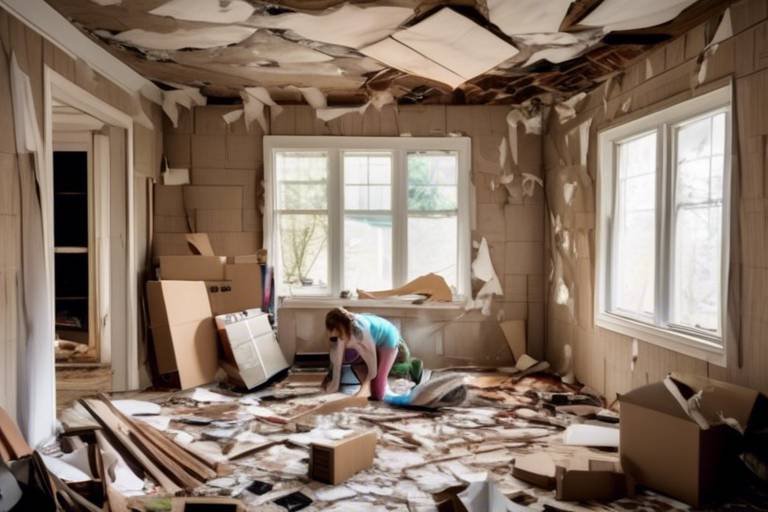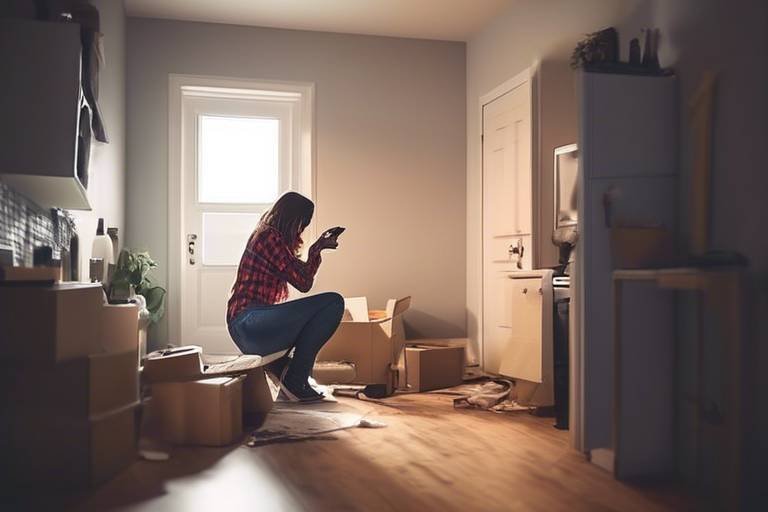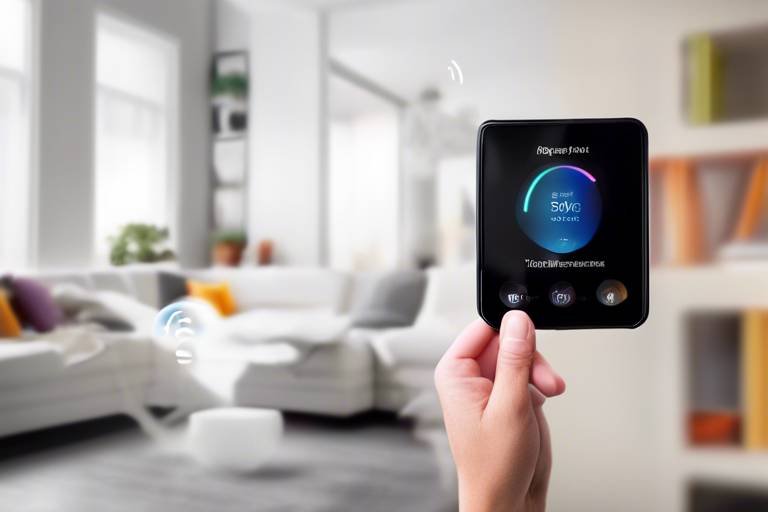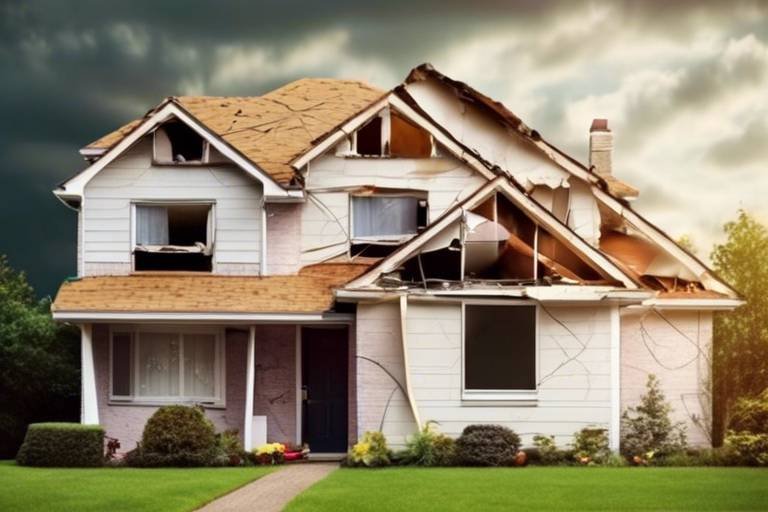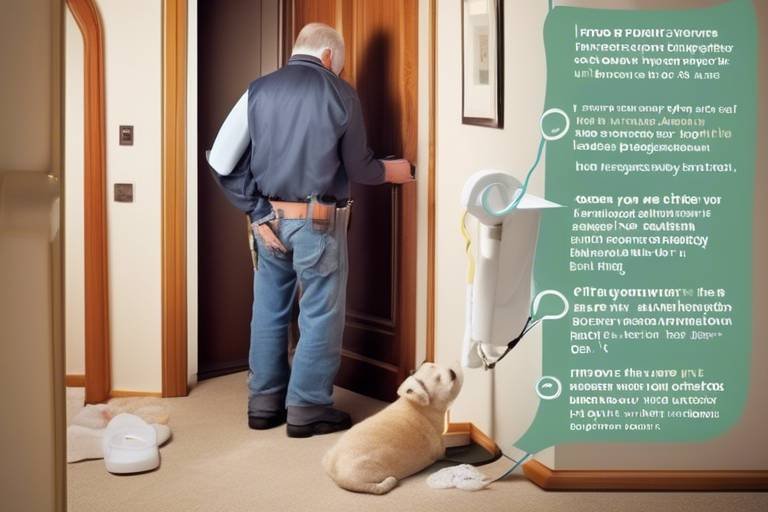How to Avoid Common Safety Hazards in the Kitchen
This article explores essential tips and strategies to prevent safety hazards in the kitchen, ensuring a safer cooking environment for everyone involved. The kitchen is often considered the heart of the home, a place where delicious meals are crafted and memories are made. However, it can also be a hotspot for accidents if proper precautions aren't taken. From slippery floors to sharp knives, understanding these hazards is the first step in creating a safe cooking space. So, let’s dive into the common safety hazards you might encounter in the kitchen and discover how to avoid them!
Identifying potential hazards in the kitchen is the first step toward prevention. The kitchen is filled with various risks that can lead to injuries. Some of the most common hazards include:
- Slips and Falls: Wet floors or cluttered spaces can easily lead to accidents.
- Cuts: Sharp knives and utensils can cause serious injuries if not handled properly.
- Burns: Stovetops, ovens, and boiling liquids pose significant burn risks.
By being aware of these hazards, you can take proactive measures to mitigate risks and ensure a safer cooking environment for yourself and others. Remember, safety in the kitchen isn't just about avoiding injuries; it's about creating a space where creativity can thrive without fear!
Knife safety is crucial in the kitchen. With a little knowledge and the right techniques, you can significantly reduce the risk of injury. The first step is understanding how to use knives correctly. Always ensure you have a stable cutting surface and use a cutting board to protect your countertops. When cutting, use a rocking motion and keep your fingers tucked in, guiding the food with your knuckles to avoid accidental cuts.
Selecting the appropriate knife for specific tasks can enhance safety and efficiency. Here’s a quick guide on common knife types and their intended uses:
| Knife Type | Use |
|---|---|
| Chef's Knife | Versatile for chopping, slicing, and dicing. |
| Paring Knife | Ideal for peeling and intricate cutting tasks. |
| Serrated Knife | Perfect for cutting bread and delicate items. |
Using the right knife not only makes your cooking easier but also helps prevent accidents. Imagine trying to slice through a loaf of bread with a chef's knife—frustrating, right? It's like using a sledgehammer to crack a nut!
Keeping knives sharp and well-maintained is vital for safety. Dull knives require more force to cut, increasing the likelihood of slips. Regularly sharpen your knives using a whetstone or a professional sharpening service. Additionally, always clean your knives immediately after use to prevent the buildup of bacteria and ensure they remain in good condition. A well-maintained knife is not just safer; it’s also a joy to use!
Where and how you store your knives can impact safety. Consider using a magnetic strip mounted on the wall, a knife block, or a drawer with a knife tray. These storage solutions help keep your knives organized and out of reach of children, reducing the risk of accidental cuts. Remember, a clutter-free kitchen is a safe kitchen!
Slips and falls are common kitchen accidents. To maintain a safe workspace, always keep the floor dry and free from clutter. If you spill something, clean it up immediately. Using non-slip mats near the sink and stove can also provide extra traction. And don’t forget about your footwear—wearing shoes with good grip can make a world of difference. Think of it as wearing the right gear for a sport; it just makes sense!
Fires can pose serious dangers in the kitchen. To prevent kitchen fires, always keep an eye on what you’re cooking. Never leave the stove unattended, and keep flammable materials like dish towels and paper away from heat sources. It's also crucial to understand how to operate kitchen appliances safely. For instance, always follow the manufacturer’s instructions and avoid overloading electrical outlets.
Understanding how to operate kitchen appliances safely is crucial. Always ensure that your appliances are in good working condition. Regularly check for frayed cords or malfunctioning parts. When using the stove or oven, keep a fire extinguisher nearby and know how to use it. It’s like having a safety net—just in case things go awry!
Being prepared for emergencies can save lives. Make sure you have fire extinguishers, smoke detectors, and a first aid kit readily available in the kitchen. Regularly check the batteries in your smoke detectors and ensure that your fire extinguisher is charged and accessible. Think of it as your kitchen's superhero squad—always ready to jump into action when needed!
Q: What should I do if I cut myself while cooking?
A: Clean the wound with soap and water, apply an antiseptic, and cover it with a bandage. If the cut is deep or bleeding heavily, seek medical attention.
Q: How can I prevent kitchen fires?
A: Always stay attentive while cooking, keep flammable items away from heat, and have a fire extinguisher on hand. Regularly check your smoke detectors too!
Q: What is the best way to store knives?
A: Use a knife block, magnetic strip, or drawer with a knife tray to keep your knives organized and out of reach of children.
Q: How often should I sharpen my knives?
A: It depends on usage, but generally, it's a good idea to sharpen your knives every few months or whenever they start to feel dull.

Understanding Kitchen Hazards
When you step into the kitchen, it might feel like a cozy haven filled with the aromas of delicious meals, but lurking beneath this inviting surface are various potential hazards that can turn a culinary adventure into a nightmare. Understanding these risks is the first crucial step in creating a safer cooking environment. From slips and falls to cuts and burns, the kitchen can be a treacherous place if proper precautions are not taken.
One of the most common hazards in the kitchen is the risk of slips and falls. These accidents often occur due to spilled liquids, food debris, or even improperly placed rugs. Imagine trying to sauté vegetables while dodging a slippery floor—it's not just distracting; it's dangerous! Ensuring that your workspace is clean and free of clutter can significantly reduce the chances of falling. Using non-slip mats in areas where spills are likely can also provide extra security.
Another major concern is the risk of cuts and lacerations. Knives are essential tools in the kitchen, but they can also be the source of serious injuries if not handled correctly. It's vital to be aware of your knife skills and to practice safe cutting techniques. For instance, always cut away from your body and keep your fingers curled under to avoid accidental nicks. Additionally, having a designated cutting board can help keep your workspace organized and minimize the risk of injury.
Then there are burns, which can occur from hot surfaces, boiling liquids, or even steam. Ever reached for a hot pot without a mitt? Ouch! To mitigate this risk, always use oven mitts or pot holders when handling hot cookware. It’s also important to be mindful of where you place hot items; keeping them at the edge of counters can lead to accidental spills or burns.
In summary, being aware of these kitchen hazards—slips, cuts, and burns—is the first step in ensuring a safer cooking experience. By maintaining a clean workspace, practicing safe knife handling, and being cautious around hot surfaces, you can significantly reduce the risks associated with kitchen activities. Remember, safety in the kitchen isn't just about avoiding accidents; it's about creating a space where you can enjoy cooking without fear!
- What are the most common kitchen hazards? The most common kitchen hazards include slips and falls, cuts and lacerations, and burns.
- How can I prevent slips in the kitchen? Keep your kitchen clean, use non-slip mats, and wear appropriate footwear to prevent slips.
- What should I do if I cut myself while cooking? Clean the wound immediately, apply pressure to stop the bleeding, and bandage it. If the cut is severe, seek medical attention.
- How can I avoid burns in the kitchen? Always use oven mitts, be cautious with hot liquids, and keep hot items away from the edge of counters.

Proper Knife Handling
Knife safety is crucial in the kitchen, and understanding how to handle knives properly can make a significant difference in preventing injuries. When you think about it, a knife is just a tool, but in the wrong hands or used incorrectly, it can become a dangerous weapon. So, how can we make sure we’re using knives safely? First, it’s essential to adopt the right cutting techniques. Always use a cutting board, and make sure it’s stable—nobody wants a slippery board sending your ingredients flying! A good grip on the knife is also vital; hold it firmly with your dominant hand while keeping your fingers tucked away from the blade.
Another important aspect is knife storage. Storing knives in a drawer without any protection is a recipe for disaster. Instead, consider using a knife block or magnetic strip to keep your blades organized and easily accessible. This not only prevents accidental cuts but also helps maintain the sharpness of the blades, as they won’t be knocking against each other. Speaking of sharpness, a dull knife is actually more dangerous than a sharp one. Why? Because it requires more force to cut through food, increasing the likelihood of slipping and causing an injury. Regular maintenance is key!
Selecting the appropriate knife for the task at hand can greatly enhance both safety and efficiency in the kitchen. For instance, using a chef’s knife for chopping vegetables is ideal, while a paring knife is perfect for peeling fruits. Here’s a quick reference table to help you choose the right knife:
| Knife Type | Best Use |
|---|---|
| Chef's Knife | Chopping, slicing, and dicing |
| Paring Knife | Peeling and intricate cutting |
| Serrated Knife | Slicing bread and soft fruits |
| Boning Knife | Deboning meat and fish |
When you have the right knife for the job, you’ll find that cutting becomes easier and safer. But let’s not forget about knife maintenance. Keeping your knives sharp is essential for safety. You can use a whetstone or a honing steel to maintain the edge. Additionally, always wash knives by hand instead of putting them in the dishwasher, as the heat and moisture can damage the blade and handle. After washing, dry them immediately to prevent rust.
Knife storage is another critical aspect of proper knife handling. As mentioned earlier, using a knife block or a magnetic strip can significantly reduce the risk of accidental cuts. You can also consider using blade guards, which are protective sheaths that cover the blade when stored. This not only protects you but also extends the life of your knives.
In conclusion, mastering proper knife handling techniques is essential for anyone who spends time in the kitchen. By choosing the right knife, maintaining its sharpness, and storing it safely, you can create a much safer cooking environment. Remember, the kitchen should be a place of creativity and enjoyment, not one of fear and accidents. So, let’s keep those knives sharp and our fingers safe!
- What should I do if I cut myself while using a knife? Clean the wound with soap and water, apply a bandage, and if the bleeding doesn’t stop, seek medical attention.
- How often should I sharpen my knives? It depends on usage, but a good rule of thumb is to sharpen them every few months or as soon as you notice a dull edge.
- Is it safe to store knives in a drawer? It’s not recommended unless they are in a protective sheath. A knife block or magnetic strip is safer.

Choosing the Right Knife
When it comes to cooking, selecting the right knife is not just about personal preference; it's about ensuring safety and efficiency in the kitchen. Imagine trying to slice through a tough piece of meat with a dull paring knife. Not only is it frustrating, but it also increases your chances of injury. Each type of knife serves a specific purpose, and understanding these differences can make your culinary experience much safer and more enjoyable.
For instance, a chef's knife is a versatile tool that can handle a variety of tasks, from chopping vegetables to slicing meat. Its broad blade allows for a rocking motion, making it easier to cut through ingredients quickly and safely. On the other hand, a paring knife is ideal for intricate tasks like peeling fruits or deveining shrimp. Using the correct knife for the job minimizes the risk of slips and accidents, allowing you to focus on the joy of cooking rather than worrying about potential injuries.
Here’s a quick breakdown of some common kitchen knives and their uses:
| Type of Knife | Best For |
|---|---|
| Chef's Knife | Chopping, slicing, dicing |
| Paring Knife | Peeling, trimming, intricate work |
| Serrated Knife | Slicing bread, tomatoes |
| Boning Knife | Deboning meat and fish |
In addition to choosing the right knife type, it's also essential to consider the knife's size and weight. A knife that's too heavy can lead to fatigue and loss of control, while one that's too light might not provide the necessary force for tougher tasks. You should feel a sense of balance and comfort when holding your knife, as this will help you maintain control while cutting, thereby reducing the risk of accidents.
Lastly, always remember to invest in quality knives. While they may come with a higher price tag, quality knives are generally safer and more effective. They stay sharper longer, require less force to use, and are often designed with safety features that prevent slips. So, when you're in the market for a new knife, think of it as an investment in your safety and culinary prowess.

Knife Maintenance Tips
Maintaining your knives is not just about keeping them sharp; it’s a crucial aspect of kitchen safety that often gets overlooked. A well-maintained knife can make your cooking experience smoother and safer, while a dull or damaged knife can lead to accidents. Imagine trying to slice through a tough piece of meat with a dull knife—you're more likely to apply excessive force, which can result in slips and cuts. So, let’s dive into some essential knife maintenance tips that will keep your blades in top shape and your kitchen safe!
First and foremost, regular sharpening is key. A sharp knife requires less force to cut through food, reducing the chance of slipping. You can sharpen your knives at home using a whetstone or a honing rod. Here’s a quick step-by-step guide:
- Start with a clean, dry knife.
- Hold the knife at a 20-degree angle against the stone.
- Swipe the blade across the stone in a smooth motion, alternating sides.
- Rinse the knife and dry it thoroughly once you’re done.
Additionally, it’s important to clean your knives properly after each use. Avoid putting them in the dishwasher, as the high heat and harsh detergents can damage the blade and handle. Instead, wash your knives by hand with warm, soapy water and dry them immediately to prevent rusting. This simple practice can significantly extend the life of your knives.
Another vital aspect of knife maintenance is storage. Improper storage can lead to dull blades and accidental cuts. Consider investing in a knife block, magnetic strip, or a protective sheath. These options not only keep your knives organized but also shield the blades from damage. For instance, a knife block provides a safe haven for your knives, while a magnetic strip allows for easy access and visibility, reducing the risk of accidents when searching for the right tool.
Lastly, don’t forget about the handles. Inspect them regularly for any signs of wear or damage. A loose handle can lead to accidents, so if you notice any issues, it’s best to replace the knife or have it repaired. Remember, a knife is an extension of your hand in the kitchen; keeping it in good condition ensures that you can cook safely and efficiently.
In summary, proper knife maintenance involves regular sharpening, careful cleaning, safe storage, and periodic inspections. By following these tips, you’ll not only enhance the performance of your knives but also create a safer cooking environment. After all, a well-cared-for knife is a happy knife, and a happy knife makes for a happy cook!
Q1: How often should I sharpen my knives?
A1: It depends on how frequently you use them. For everyday cooks, sharpening every few weeks is advisable, while occasional users may only need to sharpen their knives a few times a year.
Q2: Can I use a honing rod instead of a whetstone?
A2: Yes! A honing rod is great for realigning the edge of your knife between sharpenings. However, it doesn’t replace the need for regular sharpening with a whetstone.
Q3: What’s the best way to store my knives?
A3: The best storage options include knife blocks, magnetic strips, or protective sheaths. These methods keep your knives organized and safe from damage.
Q4: Is it safe to put my knives in the dishwasher?
A4: No, it’s not safe. The high heat and harsh detergents can damage your knives. Always hand wash and dry them immediately after use.

Safe Knife Storage
When it comes to knife safety, proper storage is just as crucial as how you use them. Imagine reaching for a knife only to accidentally cut yourself because it was carelessly left out on a counter or stuffed in a drawer. Not only can this lead to injuries, but it also creates a chaotic kitchen environment. To maintain a safe and organized kitchen, consider the following knife storage solutions that can significantly reduce the risk of accidents.
One of the most effective ways to store knives safely is by using a magnetic knife strip. These strips can be mounted on the wall, keeping your knives easily accessible while ensuring that the blades are not exposed to potential damage or accidental contact. This method not only saves space but also turns your knives into a decorative element in your kitchen. Just make sure to place the strip out of reach of children to avoid any mishaps.
If wall space is limited, a knife block can be a great alternative. Knife blocks come in various styles and materials, and they provide a safe way to store your knives while keeping them organized. When using a knife block, ensure that the knives fit snugly and that the block is placed on a stable surface. This prevents the block from tipping over, which could lead to a dangerous spill of sharp instruments.
For those who prefer a more traditional approach, consider using a drawer insert specifically designed for knives. These inserts keep knives securely in place, preventing them from moving around and potentially causing injuries. Make sure to choose an insert that fits your drawer well and allows you to see all your knives at a glance. Avoid overcrowding the drawer, as this can lead to accidents when searching for a particular knife.
Lastly, if you have children or pets in the house, it’s essential to store knives in a place that is completely out of their reach. Installing a child-proof lock on your knife drawer or using a high cabinet to store your knife block can provide an extra layer of safety. Remember, a little planning goes a long way in creating a safe cooking environment.
In conclusion, safe knife storage is a fundamental aspect of kitchen safety. By implementing these strategies, you can significantly reduce the risk of accidents and ensure that your kitchen remains a safe haven for culinary creativity. When you treat your knives with respect and store them properly, you not only protect yourself but also extend the life of your kitchen tools.
- What is the best way to store kitchen knives?
Using a magnetic knife strip or a knife block is highly recommended for safe storage. - How can I keep my knives sharp while stored?
Make sure to store them in a way that prevents them from dulling, such as using a knife block or a drawer insert. - Is it safe to store knives in a drawer?
Yes, but ensure that you use a drawer insert to keep them organized and prevent accidents. - How can I prevent my children from accessing knives?
Store knives in high cabinets or use child-proof locks on drawers to keep them out of reach.

Preventing Slips and Falls
When it comes to kitchen safety, one of the most overlooked aspects is the risk of slips and falls. These accidents can happen in the blink of an eye, and they can lead to serious injuries, especially if you're carrying something hot or sharp. So, how can you create a safer cooking environment? It all starts with maintaining a clean and organized space. Imagine trying to dance in a cluttered room—it's nearly impossible! The same goes for cooking. A tidy kitchen not only enhances your cooking experience but also minimizes hazards.
One of the first steps in preventing slips is to immediately clean up any spills. Whether it’s water, oil, or something else, a slippery floor can be a recipe for disaster. Keep a towel or mop handy, and make it a habit to wipe up spills as soon as they happen. Think of it as a quick pit stop during a race; a little maintenance can help you keep going without any major setbacks.
Another effective strategy is to use non-slip mats or rugs in areas where you frequently stand, like in front of the sink or stove. These mats provide extra grip and can significantly reduce the chance of slipping. Additionally, consider your footwear. Wearing shoes with good traction can make a world of difference. Avoid flip-flops or slippers that can easily slide off your feet. Instead, opt for closed-toe shoes that offer both comfort and stability.
Moreover, lighting plays a crucial role in preventing falls. Ensure that your kitchen is well-lit, especially in areas where you are chopping vegetables or handling hot pots. If you find yourself squinting to see what you're doing, it’s time to add some brighter bulbs or additional lighting fixtures. A well-lit space is like having a spotlight on your cooking skills, allowing you to focus without worrying about tripping over something.
Lastly, consider the layout of your kitchen. Keep frequently used items within easy reach to avoid unnecessary bending or stretching. If you must use a step stool to reach higher shelves, make sure it’s sturdy and placed on a flat surface. It’s all about creating a workspace that feels safe and comfortable, allowing you to focus on what you love—cooking!
- Clean spills immediately.
- Use non-slip mats in high-traffic areas.
- Wear shoes with good traction.
- Ensure proper lighting in the kitchen.
- Organize your kitchen for easy access to items.
By following these simple yet effective tips, you can significantly reduce the risk of slips and falls in your kitchen. Remember, a safe cooking environment not only protects you but also enhances your culinary experience. So, next time you step into your kitchen, think about these strategies and make safety a priority!
Q: What should I do if I slip and fall in the kitchen?
A: If you slip and fall, assess your injuries first. If you feel any pain or discomfort, seek medical attention. If you're okay, clean up the spill to prevent others from slipping.
Q: How can I make my kitchen more organized?
A: Use drawer organizers, shelf risers, and clear containers to keep everything in its place. Regularly declutter your kitchen to maintain an organized environment.
Q: Are there specific types of non-slip mats I should look for?
A: Look for mats made of rubber or those with textured surfaces designed specifically for kitchen use. They should be easy to clean and durable.

Fire Safety in the Kitchen
When it comes to cooking, the kitchen is often the heart of the home, but it can also be one of the most dangerous places if proper fire safety measures aren't in place. Did you know that cooking is the leading cause of home fires? That's right! With pots boiling over, grease splattering, and open flames, it’s essential to stay vigilant and informed. So, how can we ensure that our culinary adventures don’t turn into fiery disasters? Let's dive into some essential fire safety strategies that every home cook should know.
First and foremost, prevention is key. Always keep a watchful eye on what you’re cooking. Never leave the kitchen unattended while using the stove or oven, especially when frying food. Grease fires can ignite in an instant, and a moment of distraction can lead to a serious incident. If you’re stepping away for even a brief moment, it’s wise to turn off the heat. Remember, it’s better to have a slightly undercooked meal than a kitchen engulfed in flames!
Another critical aspect of fire safety is understanding how to use cooking appliances properly. For instance, when using a stovetop, ensure that the handles of pots and pans are turned inward to prevent accidental spills or burns. Additionally, keep flammable items—like dish towels, paper, and plastic utensils—away from the stove. You might think it’s safe to have that dish towel hanging nearby, but a quick flick of a flame could turn it into a fire hazard.
Knowing how to operate your kitchen appliances safely can make all the difference. Here are some best practices:
- Always read the manufacturer's instructions before using any new appliance.
- Keep the area around your stove clear of clutter.
- Regularly check for frayed cords or malfunctioning equipment.
By following these simple guidelines, you can significantly reduce the risk of kitchen fires.
Now, let’s talk about the importance of having the right tools at your disposal. A fire extinguisher is a must-have in any kitchen. Make sure it’s easily accessible and that you know how to use it. In case of a small grease fire, remember: never use water. Instead, smother the flames with a metal lid or baking soda. If the fire is too large to handle, evacuate immediately and call 911. Your safety is the most important thing!
Being prepared for emergencies can truly save lives. In addition to a fire extinguisher, ensure you have working smoke detectors installed in your kitchen and throughout your home. Test them monthly and replace batteries as needed. It’s also a good idea to have a first aid kit handy, just in case someone gets burned or injured while cooking. You never know when an accident might occur, so being prepared can make all the difference.
In summary, fire safety in the kitchen is all about being proactive. By staying attentive, using appliances correctly, and having the right safety equipment, you can enjoy cooking without the fear of fire hazards. Remember, a little bit of caution goes a long way in keeping your kitchen a safe and enjoyable space!
Q: What should I do if a grease fire starts?
A: Never use water to extinguish a grease fire. Instead, cover the pan with a metal lid or use baking soda to smother the flames. If the fire is uncontrollable, evacuate and call emergency services.
Q: How often should I check my smoke detectors?
A: It’s recommended to test your smoke detectors monthly and replace the batteries at least once a year.
Q: What type of fire extinguisher should I have in my kitchen?
A: A Class K fire extinguisher is ideal for kitchen fires, especially those involving cooking oils and fats. However, a multi-purpose extinguisher (Class ABC) can also be effective.
Q: Are there any specific cooking practices that can help prevent fires?
A: Yes! Always stay in the kitchen while cooking, keep flammable items away from heat sources, and regularly clean your cooking appliances to prevent grease buildup.

Using Cooking Appliances Safely
When it comes to using cooking appliances, safety should always be your top priority. Imagine stepping into your kitchen and feeling completely at ease, knowing that you can whip up a delicious meal without the stress of potential hazards. To achieve this, it's crucial to understand how to operate your appliances correctly and safely. Whether it's your trusty stove, oven, or microwave, each appliance comes with its own set of safety guidelines that can help prevent accidents.
First and foremost, always read the instruction manual that comes with your appliances. It may seem tedious, but these manuals are filled with essential information that can save you from mishaps. For example, did you know that some microwaves have specific guidelines for cooking certain foods? Following these instructions ensures not only your safety but also the efficiency of your cooking.
When using a stove, remember to keep the area around it clear. It's easy to get caught up in the cooking process and forget about the clutter on the counter. However, having flammable items nearby can lead to serious accidents. So, make it a habit to keep dish towels, paper towels, and any other materials away from the burner. Additionally, always turn pot handles inward to prevent accidentally knocking them over. This simple action can prevent hot liquids from spilling and causing burns.
For ovens, it's essential to preheat them properly before placing your food inside. This not only ensures even cooking but also reduces the risk of food catching fire. Furthermore, always use oven mitts or potholders when handling hot dishes. Your hands are precious, and a little extra caution can go a long way in protecting them from burns.
Now, let’s talk about microwaves. These handy appliances can be a double-edged sword. While they make cooking quick and easy, improper use can lead to dangerous situations. For instance, never attempt to microwave metal containers or aluminum foil, as they can cause sparks and potentially start a fire. Instead, opt for microwave-safe dishes. And remember, when heating liquids, always use a microwave-safe lid or cover to prevent splatters and burns.
In addition to these tips, it's crucial to regularly inspect your appliances for any signs of wear and tear. Frayed cords or malfunctioning buttons can lead to accidents, so it's best to address these issues promptly. If you notice anything unusual, don’t hesitate to contact a professional for repairs or replacements.
Lastly, consider having a fire extinguisher nearby, especially in the kitchen. It’s a small investment that can make a world of difference in an emergency. Familiarize yourself with its operation, and ensure that everyone in your household knows where it is located and how to use it. Remember, staying prepared can be the key to safety.
By following these essential tips for using cooking appliances safely, you can create a more secure cooking environment. So, the next time you step into your kitchen, you can focus on what truly matters: enjoying the process of cooking and sharing delicious meals with your loved ones.
- What should I do if my appliance catches fire? Immediately turn off the appliance if safe to do so, and use a fire extinguisher if available. If the fire is uncontrollable, evacuate and call emergency services.
- How often should I inspect my cooking appliances? Regularly check your appliances for wear and tear, at least every few months, or whenever you notice any unusual signs.
- Are there specific dishes I should avoid microwaving? Yes, avoid microwaving metal containers, aluminum foil, and certain plastics that aren’t labeled as microwave-safe.

Emergency Preparedness
When it comes to kitchen safety, being prepared for emergencies is not just a good idea—it's essential. Imagine you're in the middle of whipping up a delicious meal, and suddenly, a fire breaks out. Panic can easily set in, but if you're prepared, you can handle the situation with confidence. So, what does it mean to be truly prepared for emergencies in your kitchen? Well, it starts with having the right tools and knowledge at your fingertips.
First and foremost, having a fire extinguisher within reach is crucial. You wouldn’t want to run around looking for one when flames are licking at your countertops. Ideally, you should have a Class K fire extinguisher, specifically designed for kitchen fires caused by cooking oils and fats. Make sure it’s easily accessible, perhaps mounted on a wall near your cooking area, and that everyone in your household knows where it is and how to use it.
Next up, smoke detectors are your best friends. They can alert you to smoke before it turns into a full-blown fire. Ensure that you have a smoke detector installed in or near your kitchen, and remember to test it monthly. Change the batteries at least once a year, because a dead battery won’t do you any good when you need it most. And while you’re at it, consider investing in a carbon monoxide detector as well, to protect against this silent killer.
Additionally, having a well-stocked first aid kit can make a world of difference. Accidents happen, whether it's a cut from a knife or a burn from a hot pan. A well-equipped first aid kit should include:
- Adhesive bandages
- Antiseptic wipes
- Burn cream
- Gauze pads
- Medical tape
- Scissors
Make sure to keep it in a location that’s easy to access but out of reach of young children. Regularly check the contents of your first aid kit to ensure that supplies are not expired and that you have everything you need in case of an emergency.
Lastly, having an emergency plan is just as important as having the right tools. Sit down with your family and discuss what to do in case of a kitchen fire or other emergencies. Make sure everyone knows the escape routes and where to meet outside. Practice makes perfect, and by rehearsing your plan, you can reduce panic and confusion when an actual emergency arises.
In summary, being prepared for emergencies in the kitchen involves a combination of having the right equipment, maintaining it, and having a solid plan in place. It’s not just about preventing accidents; it’s about being ready to respond effectively when they do occur. Remember, a little preparation can go a long way in keeping you and your loved ones safe while you enjoy the culinary arts!
Q: What type of fire extinguisher is best for kitchen use?
A: A Class K fire extinguisher is specifically designed for kitchen fires caused by cooking oils and fats. It's best to have this type on hand.
Q: How often should I check my smoke detector?
A: You should test your smoke detector monthly and change the batteries at least once a year to ensure it’s functioning properly.
Q: What should I include in my first aid kit for kitchen emergencies?
A: Your first aid kit should include adhesive bandages, antiseptic wipes, burn cream, gauze pads, medical tape, and scissors, among other supplies.
Q: How can I prepare my family for a kitchen emergency?
A: Discuss and create an emergency plan with your family, ensuring everyone knows the escape routes and where to meet outside in case of an emergency.
Frequently Asked Questions
- What are the most common kitchen hazards?
The most common kitchen hazards include slips, cuts, burns, and fires. Being aware of these risks is the first step in preventing accidents while cooking. For instance, water spills can lead to slips, while improper knife use can result in cuts.
- How can I ensure safe knife handling?
To ensure safe knife handling, always use a cutting board, keep your knives sharp, and store them properly. When cutting, use the right technique, and never try to catch a falling knife. Remember, a dull knife is more dangerous than a sharp one because it requires more force to cut.
- What should I do to prevent slips and falls in the kitchen?
Preventing slips and falls can be as simple as keeping your kitchen tidy. Clean up spills immediately, use non-slip mats, and wear appropriate footwear. Additionally, make sure that your kitchen is well-lit to avoid any hidden hazards.
- How can I improve fire safety in my kitchen?
Improving fire safety involves using appliances correctly, keeping flammable materials away from heat sources, and having a fire extinguisher readily available. Regularly check smoke detectors and ensure they are functioning properly to alert you in case of a fire.
- What should I include in my kitchen emergency preparedness kit?
Your kitchen emergency preparedness kit should include a fire extinguisher, smoke detectors, a first aid kit, and a list of emergency contacts. It's also wise to have a manual for your appliances and a plan for how to respond to different emergencies.


